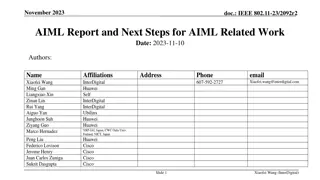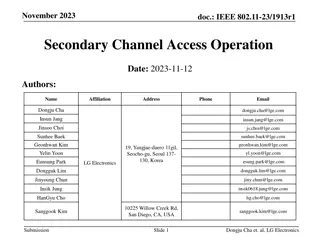IEEE 802.11-23/1935r0 - Secondary Channel Usage Discussions
Explore the discussions on secondary channel usage in IEEE 802.11-23/1935r0, including topics like RU index, BW negotiation, avoiding medium synchronization loss, and single/multiple secondary backoff 20MHz channels. Discover insights on non-primary backoff 20MHz channel locations, transitioning delays, and frame transmission methods. Delve into scenarios where non-primary backoff channels are utilized when the primary channel is busy, providing alternatives for frame exchanges until the primary channel becomes idle again.
Download Presentation

Please find below an Image/Link to download the presentation.
The content on the website is provided AS IS for your information and personal use only. It may not be sold, licensed, or shared on other websites without obtaining consent from the author.If you encounter any issues during the download, it is possible that the publisher has removed the file from their server.
You are allowed to download the files provided on this website for personal or commercial use, subject to the condition that they are used lawfully. All files are the property of their respective owners.
The content on the website is provided AS IS for your information and personal use only. It may not be sold, licensed, or shared on other websites without obtaining consent from the author.
E N D
Presentation Transcript
11/10/2023 Doc.: IEEE 802.11-23/1935r0 Secondary Channel Usage Follow Up Date: 2023-11-10 Authors: Affiliations Address Phone email Name Liwen Chu Kiseon Ryu Huizhao Wang Hongyuan Zhang Rui Cao Sudhir Srinivasa Hui-Ling Lou NXP Submission Slide 1 Liwen Chu et al (NXP)
11/10/2023 Doc.: IEEE 802.11-23/1935r0 Recap We discussed the secondary channel usage in several presentations: The RU index, BW negotiation in secondary channel The method to avoid the losing of the medium synchronization when returning back to primary channel The discussion of single and multiple secondary backoff 20MHz channels announced by the AP. Prefer single secondary backoff 20MHz channel. The method to make sure a peer device is ready when transmitting the frame to the peer device Transition delay, STA s availability polling on secondary channel. Submission Slide 2 Liwen Chu et al (NXP)
11/10/2023 Doc.: IEEE 802.11-23/1935r0 Non-Primary Backoff 20MHz Channel Location Each 80MHz channel covered by a BSS operating channel can t have more than one backoff 20MHz channel (a backoff 20MHz channel is either a non-primary backoff 20MHz channel or the primary 20MHz channel) In a BSS with N 20MHz channels, one non-primary backoff 20MHz channel (the backoff 20MHz channel that is not primary 20MHz channel) is defined, and the non- primary backoff 20MHz channel is on non-primary (secondary) (N/2)*20 MHz channel Another variant is that more than one non-primary backoff 20MHz channel can be defined, and at least one non-primary backoff 20MHz channel is on non-primary (secondary) (N/2)*20 MHz channel Submission Slide 3 Liwen Chu et al (NXP)
11/10/2023 Doc.: IEEE 802.11-23/1935r0 Single Non-primary Backoff 20MHz Channel With single non-primary 20MHz backoff channel, if the primary channel is busy because of the OBSS TXOP or AP s in-device non-WiFi radio activity SP, the AP and its associated STAs may switch to non-primary backoff 20MHz channel for frame exchanges until the primary channel is idle again. Additionally, the following information can be considered: If the OBSS TXOP BW (the BW of the inter-BSS PPDU) covers the non-primary backoff 20MHz channel, the AP and STAs will not switch to the non-primary backoff 20MHz channel. If the length of the TXOP is less than a threshold announced by the AP, the AP and STAs will not switch to the non-primary backoff 20MHz channel. Submission Slide 4 Liwen Chu et al (NXP)
11/10/2023 Doc.: IEEE 802.11-23/1935r0 Multiple Non-primary Backoff 20MHz Channels (1) With multiple non-primary 20MHz backoff channels, if the primary channel is busy because of the OBSS TXOP or AP s in-device non-WiFi radio activity SP, the AP and its associated STAs may switch to one of the non-primary backoff 20MHz channels for frame exchanges until the primary channel is idle again. Additionally, the following information can be considered: The AP announces the priority of the various non-primary backoff 20MHz channels. A non-primary backoff 20MHz channel that has highest priority and is not covered by the primary channel behavior (per the BW of the OBSS TXOP etc.) will be the non-primary backoff 20MHz channel to be switched to for the frame exchanges. If the OBSS TXOP BW (the BW of the inter-BSS PPDU) covers all the non-primary backoff 20MHz channels, the AP and STAs will not switch to the non-primary backoff 20MHz channel. If the length of the TXOP is less than a threshold announced by the AP, the AP and STAs will not switch to the non-primary backoff 20MHz channel. The length of the TXOP is decided by sum of the the remaining time of the detected PPDU and the value in the Duration field of MAC header (in TXOP Duration of the PHY header). Submission Slide 5 Liwen Chu et al (NXP)
11/10/2023 Doc.: IEEE 802.11-23/1935r0 Multiple Non-primary Backoff 20MHz Channels (2) Switching among non-primary backoff 20MHz channels or not Option 1: the switching from one non-primary backoff 20MHz channel to another non-primary 20MHz channel is disallowed. This option is preferable if multiple secondary backoff 20MHz channels are allowed. Option 2: the switching from one non-primary backoff 20MHz channel to another non-primary 20MHz channel is allowed. In order to increase the chance that AP and STAs switch to the same non-primary backoff 20MHz channel, the following are defined The AP and STAs switch from non-primary backoff 20MHz channel 1 to non-primary backoff 20MHz channel 2 if the following are true non-primary backoff 20MHz channel 2 has lower priority than non-primary backoff 20MHz channel 1. There is no another non-primary backoff 20MHz channel with the priority higher than non-primary backoff 20MHz channel 2 and lower than non-primary backoff 20MHz channel 1. The TXOP of the non-primary backoff 20MHz channel 1 is longer than a threshold. The remaining time of the primary 20MHz channel s TXOP is longer than a threshold. Submission Slide 6 Liwen Chu et al (NXP)
11/10/2023 Doc.: IEEE 802.11-23/1935r0 TXOP Responder s Polling in Non-primary Channel The following frame exchange sequences are used to poll TXOP responder s available in non-primary channel: (MU-)RTS + CTS BSRP (or BQRP) Trigger + QoS Null Submission Slide 7 Liwen Chu et al (NXP)
11/10/2023 Doc.: IEEE 802.11-23/1935r0 Virtual AP Consideration The criteria to switch from the primary channel to secondary channel need to be same for all virtual APs that support the switch OBSS TXOP length threshold for the switch. If the first virtual AP enables the subchannel switch and the second virtual AP in the same AP device working on the same channel has the associated STAs that support subchannel switch, the second AP needs to enable the subchannel switch Submission Slide 8 Liwen Chu et al (NXP)
11/10/2023 Doc.: IEEE 802.11-23/1935r0 R-TWT and non-primary Channel The simple solution for R-TWT and non-primary channel usage is that when switching to a non-primary subchannel, the R-TWT rules are used as it is. However, the R-TWT members may not support subchannel switch. Other variants: A variant is that an AP announces through Management frames (e.g. in Beacons) that the R-TWT rules are not applied when switching to a non-primary subchannel if no R-TWT STA supports subchannel switch. The STAs will act accordingly per AP s announcement. The AP may not stop its non low latency traffic frame exchanges at the start time of its R-TWT SP if no R-TWT STA supports subchannel switch. Further the AP may not stop its non low latency traffic frame exchanges at the start time of one of its R-TWT SP if no member of the R-TWT member supports subchannel switch. Submission Slide 9 Liwen Chu et al (NXP)
11/10/2023 Doc.: IEEE 802.11-23/1935r0 (D)TBTT and Non-primary Channel Usage When an AP as the TXOP holder has a TXOP in non-primary channel(s) that covers its TBTT, the AP will not schedule its Beacon transmission at its TBTT. When an AP as the TXOP holder has a TXOP in non-primary channel(s) that covers its DTBTT, the AP will not schedule its group-addressed frame transmission at its DTBTT. Submission Slide 10 Liwen Chu et al (NXP)
11/10/2023 Doc.: IEEE 802.11-23/1935r0 Time to Switch to Secondary Channel The selected time to switch to secondary channel should guarantee that the peer devices switch to the secondary channel at almost the same time: When detecting OBSS TXOP, an AP/STA switches to non-primary channel after receiving the first responding frame (or SIFS + delta after the responding PPDU) or the frame following the first responding frame if the first responding frame is not detected. If the responding frame (e.g. the responding frame is in TB PPDU whose soliciting Trigger is not received) can t be decoded, the PPDU detecting is applied If a STA/AP can t figure out from the received frame/PPDU whether the detected TXOP is OBSS TXOP, the STA/AP will not switch to secondary channel within the detected TXOP. Submission Slide 11 Liwen Chu et al (NXP)
11/10/2023 Doc.: IEEE 802.11-23/1935r0 Non-primary Channel Combination Once the backoff procedure in a non-primary backoff 20MHz channel becomes zero, the non-primary backoff 20MHz channel can be aggregated with the other non-primary 20MHz channel(s) for the frame exchanges. Submission Slide 12 Liwen Chu et al (NXP)
11/10/2023 Doc.: IEEE 802.11-23/1935r0 RU Index Option 1 the RU index is acquired based on the PPDU BW and through treating the non-primary backoff 20MHz channel as the primary 20MHz channel When multiple backoff 20MHz channel is covered by the PPDU BW, the backoff 20MHz channel with highest priority will be treated as the primary 20MHz channel. When the primary 20MHz channel is covered by the PPDU BW, the RU Index will be coded as if no channel switch happens. Option2 the RU index is acquired based on the whole BW of the BSS and the primary 20MHz channel Non-primary subchannel Backoff 20MHz channel UHR TB PPDU (the RU Indexes of the RUs are coded per 320MHz BW PPDU and the primary 20MHz channel. Primary subchannel Primary 20MHz channel Submission Slide 13 Liwen Chu et al (NXP)
11/10/2023 Doc.: IEEE 802.11-23/1935r0 TXOP Protection If the backoff counter in non-primary backoff 20MHz channel becomes 0, the dynamic BW negotiation is done through treating the non-primary backoff 20MHz channel as the primary 20MHz channel. When multiple backoff 20MHz channel is covered by the PPDU BW, the backoff 20MHz channel with highest priority will be treated as the primary 20MHz channel. Another variant is to allow dynamic puncture in (MU-)RTS + CTS frame exchange. Dynamic BD negotiation Non-primary subchannel Backoff 20MHz channel RTS CTS Primary subchannel Primary 20MHz channel Submission Slide 14 Liwen Chu et al (NXP)
11/10/2023 Doc.: IEEE 802.11-23/1935r0 Summary The various aspects related to secondary channel usage are discussed RU index and BW negotiation Secondary backoff channel location, Single vs multiple secondary backoff channels Time to switch from primary backoff channel to secondary backoff channel. Secondary channel usage and virtual APs, TBTT, R-TWT etc. We prefer single secondary backoff channel. If multiple secondary backoff channels are allowed in a BSS, the switch from one secondary backoff channel to another secondary backoff channel should be disallowed. Submission Slide 15 Liwen Chu et al (NXP)























